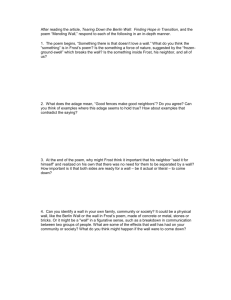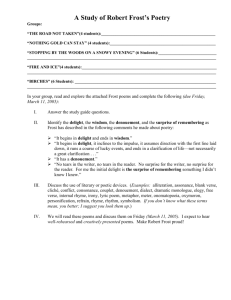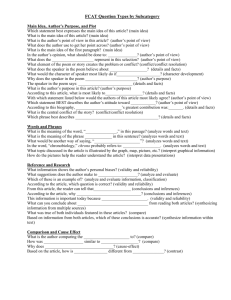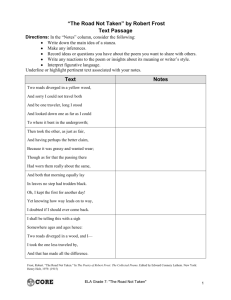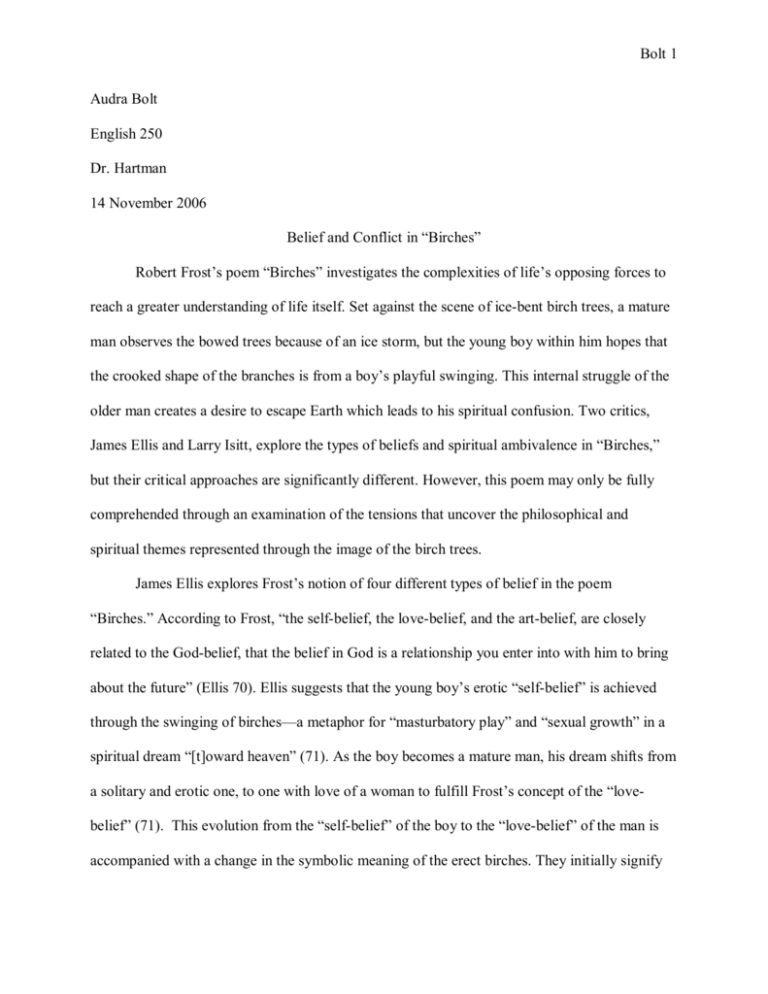
Bolt 1
Audra Bolt
English 250
Dr. Hartman
14 November 2006
Belief and Conflict in “Birches”
Robert Frost’s poem “Birches” investigates the complexities of life’s opposing forces to
reach a greater understanding of life itself. Set against the scene of ice-bent birch trees, a mature
man observes the bowed trees because of an ice storm, but the young boy within him hopes that
the crooked shape of the branches is from a boy’s playful swinging. This internal struggle of the
older man creates a desire to escape Earth which leads to his spiritual confusion. Two critics,
James Ellis and Larry Isitt, explore the types of beliefs and spiritual ambivalence in “Birches,”
but their critical approaches are significantly different. However, this poem may only be fully
comprehended through an examination of the tensions that uncover the philosophical and
spiritual themes represented through the image of the birch trees.
James Ellis explores Frost’s notion of four different types of belief in the poem
“Birches.” According to Frost, “the self-belief, the love-belief, and the art-belief, are closely
related to the God-belief, that the belief in God is a relationship you enter into with him to bring
about the future” (Ellis 70). Ellis suggests that the young boy’s erotic “self-belief” is achieved
through the swinging of birches—a metaphor for “masturbatory play” and “sexual growth” in a
spiritual dream “[t]oward heaven” (71). As the boy becomes a mature man, his dream shifts from
a solitary and erotic one, to one with love of a woman to fulfill Frost’s concept of the “lovebelief” (71). This evolution from the “self-belief” of the boy to the “love-belief” of the man is
accompanied with a change in the symbolic meaning of the erect birches. They initially signify
Bolt 2
the phallic sexuality and “erotic impulse toward the spiritual,” but shift to the girl who is the
embodiment of his heavenly aspiration for a romantic, and sexual, relationship (71). In the
conclusion of the poem, Ellis claims the adult speaker claims that he wishes to be a swinger of
birches “when [he’s] weary of considerations,” but knows that love, and the achievement of the
“love-belief” is best suited on earth (73). Ellis then states that the boy’s “self-belief” and the
man’s “love belief” are expressed through the poetic craft of the poem by means of the “artbelief” so that the speaker may make sense of Earth’s chaos to understand his “God-belief” (73).
Ellis uses Frost’s essay “Education by Poetry” about the four different types of belief as a
prescriptive guideline for interpreting “Birches”, which forces a strained and far-reaching
reading of the poem. In his application of Frost’s beliefs, Ellis uses solid quotations that support
his claims, but makes too many sweeping generalizations in applying them. For example, he
claims that the lines “[b]y riding them down over and over again/ Until he took the stiffness out
of them, /And not one but hung limp” (lines 29-31), describe the act of masturbation (71).
Similarly the majority of the poem, according to Ellis, is about sexuality and that the birches are
both a phallic symbol and a representation of the female as a sexual partner. Although the poem
may contain certain sexual overtones, sexuality is certainly not the focus. Ellis also looses sight
of the more traditional meaning of the poem and ignores the significance of the tension between
dream and reality and the need to escape, which Isitt brilliantly does.
Larry Isitt develops a more convincing argument that explores man’s spiritual journey set
against the bent image of the birches that symbolizes the transient escape from life’s
“considerations.” In the beginning of the poem, the speaker sees the bent trees and “like[s] to
think some boy’s been swinging them” (line 3), but acknowledges that the ice storms are the
actual cause of their shape; this tension between wish and reality, a boy’s playful swinging and
Bolt 3
an ice storm, is central to understanding the poem. Isitt cautions the reader who gets caught up in
the beautiful images of the “sunlight refracted through frozen ice” and branches reminiscent of
girls drying their hair in the sun because of the “religious pessimissim” that saturates the poem
(14). Isitt asserts that the juxtaposition of the romantic image of the boy’s swinging with the
“matter of fact” “Truth” of the treachery of ice storm is a “blunt announcement of reality that
constantly undercuts our illusions” and the scenic beauty of the storm’s aftermath should not
hinder readers from seeing darker implications (14).
As Isitt suggests, swinging on birches is a metaphor for the “desire to leave earth itself, to
go where it must be better” (15). In efforts to fulfill this desire, the speaker imagines climbing
“Toward heaven,” but Isitt astutely points out that he does actually wish to arrive there because it
is “beyond Frost’s own senses and reason to detect” (15). He also indicates that “Toward” is the
only italicized word, as to purposefully emphasize the “impossibility of arriving by faith at
anything definite” (15). Therefore, Isitt believes that “despite life’s burdens which make us, at
times, long to escape to some transcendental hiding place, it is on earth, not in heaven, where we
must find our fulfillment” (13).
Isitt develops strong arguments and uses textual evidence to support his claims. In his
method of interpretation, he seeks to expose the tensions of dream and reality, playful swinging
and ice storms, and to pivot the romantic, optimistic images of nature with the pessimistic views
of spirituality. In doing so, he is able to penetrate far deeper into life’s conflict represented in the
poem than Ellis was able to do. After all, is it not the tensions and “considerations” of life that
are the catalysts that prompt us to “get away from earth awhile” (line 48)?
Isitt’s idea of conflicting images or tensions in the poem creates avenues for other readers
to develop their own interpretations of the human experience—especially the spiritual, internal
Bolt 4
conflict of the speaker and the type of escape he wishes to obtain. Isitt suggests a feeling of
despair in the poem through the reality of the ice storm, but the internal conflict of the speaker
also heightens this pessimism. It is clear that the speaker of the poem is an older man looking
back on his childhood. The tension here is between the mature man who is weighed down by
life’s “considerations” and wishes to climb the birch trees to escape, whereas the young, innocent
boy’s purpose is to merely play on the branches for entertainment. One may suggest that this
need for escape points toward a dark void and confusion within the adult speaker about his own
spirituality and outlook on life.
This confusion in the speaker is heightened when he considers the type of escape for
which he yearns. First, there is a tension between the idea of escape and an actual, physical
escape from earth. The speaker wishes to “get away from the earth awhile / And then come back
to it” (lines 48-49). He does not want to physically leave earth, but instead wants to leave the
tensions that are weighing him down. He knows that the only physical escape from earth is
through death, but he fears death and complete transcendence because of his religious
uncertainty.
Further, the speaker simply wishes for a temporary escape that only the birch trees might
offer. The symbol of the birch trees is perfect for this escape—the trees have roots that tie the
speaker to Earth so that a permanent escape is impossible. The speaker imagines climbing a tree
“Toward heaven, till the tree could bear no more, / But dipped its top and set [him] down again”
(lines 56-57). The speaker never leaves Earth, even in his imagination, but climbs to the top of
the tree “Toward heaven,” until he is gently set down back on firm ground. In fact, he
acknowledges “Earth’s the right place for love” (line 52), and does not want to escape Earth—
Bolt 5
except in his dreams; therefore, it is through dreaming where he finds a safe, temporary retreat
from the burdens of everyday life.
“Birches” is a complex poem full of images and conflicts that allows for a multitude of
interpretations. Ellis suggests that the poem is about four different types of belief—self, love, art,
and God—and that the birches are representative of sexuality. Whereas his reading seems too
radical and far-fetched, Isitt develops a more traditional and acceptable interpretation. He
suggests that the birches represent the human need to escape reality, if only temporarily in one’s
dreams, to value life’s experiences with a fresh outlook. Isitt’s approach for deriving meaning
from Frost’s poem is to critically examine the opposing images and ideas to demonstrate the
internal and spiritual conflict of the speaker. It is only when the conflicts are exposed that a
reader may fully appreciate the true significance of the birch trees.
Bolt 6
Works Cited
Ellis, James. “Robert Frost’s Four Types of Belief in ‘Birches.’” The Robert Frost Review.
(Fall 1993): 70-74.
Frost, Robert. “Birches.” The Norton Anthology of American Literature. Ed. Nina Baym. New
York: Norton, 2003. 1189-1190.
Isitt, Larry. “Dark Climber: Robert Frost’s Spiritual Ambivalence in ‘Birches.’” The Robert
Frost Review. (Fall 1994): 13-16.


